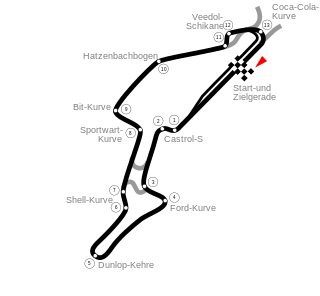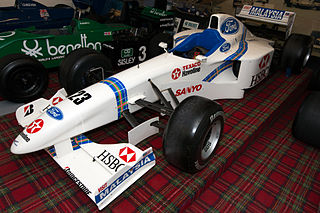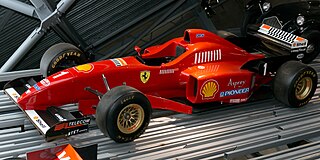
The 1995 Brazilian Grand Prix was a Formula One motor race held on 26 March 1995 at the Autódromo José Carlos Pace, São Paulo, Brazil. It was the first round of the 1995 Formula One World Championship. Michael Schumacher of the Benetton team won the 71-lap race from second position. David Coulthard finished second in a Williams car, with Gerhard Berger third in a Ferrari. Damon Hill, who started the race from pole position, spun out while leading on lap 30 with an apparent gearbox problem, which was later found to be a suspension failure. Schumacher's win came despite Benetton encountering steering problems with his car during Friday practice, leading to him crashing heavily and necessitating steering component changes for the rest of the event. Despite Schumacher's victory, Hill proved to be faster during the race and seemed to be on course for a comfortable victory before his sudden retirement.

The 1995 Monaco Grand Prix was a Formula One motor race held on 28 May 1995 at the Circuit de Monaco, Monte Carlo, Monaco. It was the fifth round of the 1995 Formula One season. The 78-lap race was won by Michael Schumacher for the Benetton team after starting from second position. Damon Hill finished second for Williams after starting from pole position and leading the first 23 laps of the race, ahead of Gerhard Berger in a Ferrari car. The remaining points-scoring positions were filled by Johnny Herbert in the second Benetton, Mark Blundell (McLaren) and Heinz-Harald Frentzen (Sauber). Schumacher's win was his third of the season thus far and extended his lead in the World Drivers' Championship over Hill to five points. It was also Renault's first win in the Monaco Grand Prix, as Benetton's engine supplier.

The 1995 British Grand Prix was a Formula One motor race held on 16 July 1995 at Silverstone Circuit, Silverstone, Northamptonshire, England. It was the eighth round of the 1995 Formula One World Championship. Johnny Herbert for the Benetton team won the 61-lap race from fifth position. Jean Alesi finished second in a Ferrari, with David Coulthard third in a Williams car. The remaining points-scoring positions were filled by Olivier Panis (Ligier), Mark Blundell (McLaren) and Heinz-Harald Frentzen (Sauber). Herbert's victory was his first in Formula One, and the Benetton team's fifth of the season.

The 1995 European Grand Prix was a Formula One motor race held on 1 October 1995 at the Nürburgring, Nürburg, Germany. It was the fourteenth race of the 1995 Formula One World Championship and the first to be held there since 1985. Michael Schumacher for the Benetton team won the 67-lap race starting from third position. Jean Alesi finished second in a Ferrari, with David Coulthard, who started the Grand Prix from pole position, third in a Williams car. This was also the last F1 race for three drivers: Massimiliano Papis, Gabriele Tarquini, and Jean-Denis Délétraz.

The 1995 Pacific Grand Prix was a Formula One motor race held on 22 October 1995 at the TI Circuit, Aida, Japan. It was the fifteenth round of the 1995 Formula One World Championship. Michael Schumacher for the Benetton team won the 83-lap race starting from third position. David Coulthard, who started the Grand Prix from pole position, finished second in a Williams car, with Damon Hill third in the other Williams. Schumacher's win confirmed him as 1995 Drivers' Champion, as Hill could not pass Schumacher's points total with only two races remaining. This was also the last race for Jean-Christophe Boullion.

The 1995 Japanese Grand Prix was a Formula One motor race held at the Suzuka Circuit, Suzuka on 29 October 1995. It was the sixteenth and penultimate race of the 1995 Formula One World Championship. The 53-lap race was won from pole position by German Michael Schumacher, driving a Benetton-Renault, with Finn Mika Häkkinen second in a McLaren-Mercedes and Schumacher's British teammate Johnny Herbert third.

The 1995 FIA Formula One World Championship was the 49th season of FIA Formula One motor racing. It featured the 1995 Formula One World Championship for Drivers and the 1995 Formula One World Championship for Constructors, which were contested concurrently over a seventeen-race series that commenced on 26 March and ended on 12 November.
Fondmetal S.p.A. is an Italian manufacturer of alloy wheels, founded in 1972 by Gabriele Rumi.

Forti Corse, commonly known as Forti, was an Italian motor racing team chiefly known for its brief and unsuccessful involvement in Formula One in the mid-1990s. It was established in the late 1970s and competed in lower formulae for two decades. The team's successes during this period included four Drivers' Championships in Italian Formula Three during the 1980s, and race wins in the International Formula 3000 championship, in which it competed from 1987 to 1994. From 1992, team co-founder Guido Forti developed a relationship with the wealthy Brazilian businessman Abílio dos Santos Diniz that gave Diniz's racing driver son, Pedro, a permanent seat in the team and the outfit a sufficiently high budget to consider entering Formula One.

The Minardi M198 was the car with which the Minardi team competed in the 1998 Formula One World Championship.

The Stewart SF01 was the car that the Stewart Formula One team competed with in the 1997 Formula One season, and the first car constructed by the team. It was driven by Rubens Barrichello and Jan Magnussen, the latter who had brief race experience with McLaren in 1995.

The Ferrari F310, and its evolution, the F310B, were the Formula One racing cars with which the Ferrari team competed in the 1996 and 1997 seasons. It was driven in both years by Michael Schumacher, who was swapped with Benetton in favour of Jean Alesi, and Eddie Irvine, who replaced Gerhard Berger.

The Benetton B196 is a Formula One racing car with which the Benetton team competed in the 1996 Formula One World Championship. It was driven by the experienced pairing of Jean Alesi and Gerhard Berger, who both moved from Ferrari to replace departing 1994 and 1995 champion Michael Schumacher and his number two, Johnny Herbert. It was Berger's second stint with Benetton having last driven for them back in 1986.
Sergio Rinland is an Argentine engineer best known for his work in Formula One. He is currently owner and managing director of the automotive engineering and management consulting company Astauto Ltd.

The Forti FG03 was the car with which the Forti team competed in part of the 1996 Formula One season. It was designed by Chris Radage and Riccardo de Marco. It was driven by Luca Badoer and Andrea Montermini, both of whom were in their first year with the team.

The Larrousse LH94 was the car with which the Larrousse team competed in the 1994 Formula One World Championship. It was the second car to be fully constructed by Larrousse, which had previously contracted specialist chassis-builders to build its cars: Lola from 1987 to 1991 and Fondmetal in 1992. The LH94 was also the final car to be built and raced by Larrousse, as the team did not survive into 1995 owing to financial problems.
The 107% rule is a sporting regulation affecting Formula One racing qualifying sessions. During the first phase of qualifying, if the circuit is dry, any driver who is eliminated in the first qualifying session and fails to set a lap within 107% of the fastest time in that session will not be allowed to start the race without permission from the race stewards. For example, if the fastest Q1 lap time was 100 seconds, each driver who is eliminated in the session must complete at least one lap within 107 seconds to guarantee a race start. The 107% rule was introduced for the 1996 season and remained in force until 2002. It was reintroduced for the 2011 season with minor modifications due to the knock-out qualifying format.

The Lola T93/30 was the Formula One car built by Lola Cars and raced by the BMS Scuderia Italia team for the 1993 Formula One season. Scuderia Italia, which did not construct its own cars, had previously run Dallara chassis since its first season in 1988, but team owner Beppe Lucchini elected to switch to Lola after an uncompetitive 1992 season.
Shannon Racing, or the Shannon Racing Team, was a short-lived motorsport team that was briefly involved with the Forti Formula One team during the 1996 season. It was owned by a parent company known as FinFirst. Both entities were registered in the Republic of Ireland, but funded by Italian backers.
The Fondmetal GR02 was a Formula One racing car designed by Sergio Rinland and his Astauto studio for the 1992 Formula One season. Built to replace the Fondmetal GR01, as Fondmetal's team boss Gabriele Rumi had never been impressed by that car or its predecessor, the Fomet-1, the GR02 used the same 3.5-litre Ford HBA5 V8 engine as its predecessor. Gabriele Tarquini gave the GR02 its début at the 1992 Canadian Grand Prix, whilst team mate Andrea Chiesa first drove it in the following 1992 French Grand Prix. Although the GR02 showed promise, and drew praise from the media, Fondmetal's financial difficulties meant that they withdrew from Formula One after the 1992 Italian Grand Prix.


















